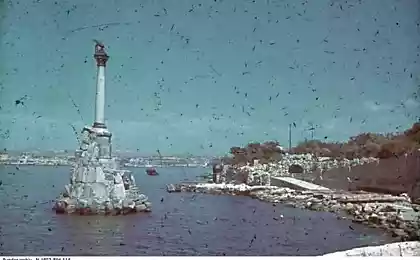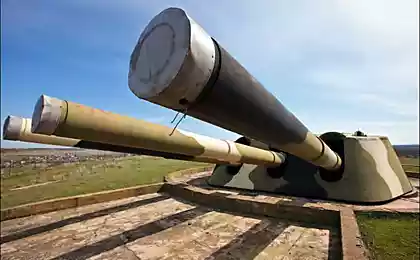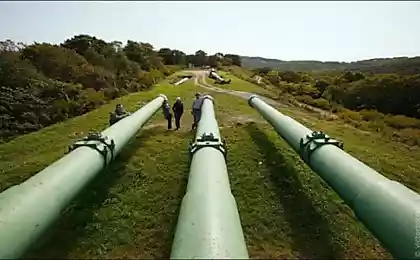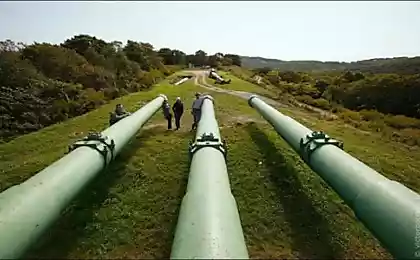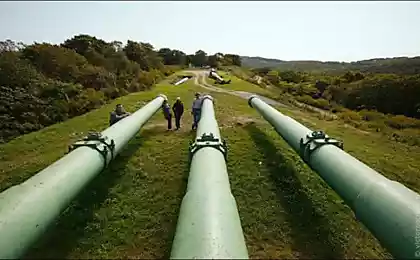1242
35th Battery - exploit the tragedy of Sevastopol
Writes blogger aquatek-filips:
This report I prepared for a long time, trying to make it as interesting as possible for both the reader and encourage thinking about the historical role of the place, which will be discussed. To this end, I traveled twice to take photographs with interest picking up historical facts.
35 Battery.
The site, which is one of the most sacred for many residents of Sevastopol.
The site, which in June and July 1942 was the last snout heroic defense of Sevastopol for the remaining 80 thousand of its defenders.
The place where it was made the fateful decision to terminate the defense and evacuation command structure.
The place has become a sort of quintessence of both the national and exploit the people's tragedy ...
36 photos
1. boulder over the Nazis blasted by artillery unit resembles grieving for the dead soldier

35th Coastal Battery tower - one of the most powerful fortifications of the coastal defense of the Black Sea Fleet's main base. Started construction in 1913 on Cape Khersones on the project of the military engineer General N.A.Buynitskogo. Initially had a number 25. In 1915, construction was halted, and the battery is being completed in 1924-1927. She was armed with two 305-mm twin tower installations "MB-2-12", designed and manufactured the Leningrad Metal Plant (gun machines and machine parts have been used to cook - shot of the towers of the battleship "Poltava" Baltic Fleet). The weight of the projectile - 471 kg, and range - up to 42 km. On your device battery consisted of two artillery units (reinforced concrete blocks, which were installed gun turrets). One of the destroyed artillery units I have shown in the first photo. In the second gun unit can be reached through the main entrance to the museum 35 battery. But more detail about the history of the battery, I will write to the end of the report, but for now - photo-excursion.
2. The main entrance to the main premises battery
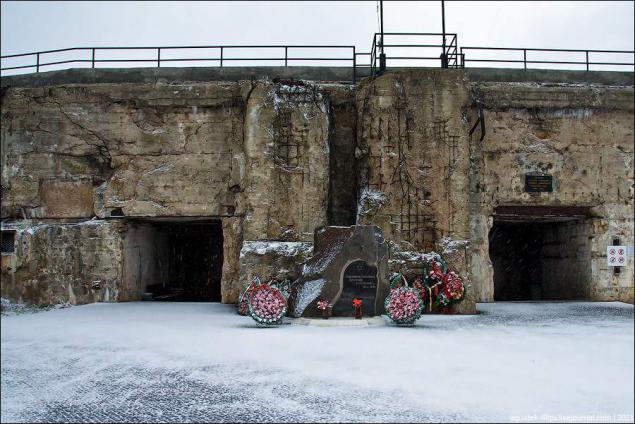
In the postwar period, the 35th coastal battery was not restored, but some of its buildings used for existing 130-mm coastal battery, so look for us to strengthen remained virtually intact.
3. On the day when I went to shoot the battery went to Sevastopol rare snow. Scratchy, as if emphasizing the tragedy of this place. Reinforced concrete structures now have the form, remaining after the events of the distant 1942
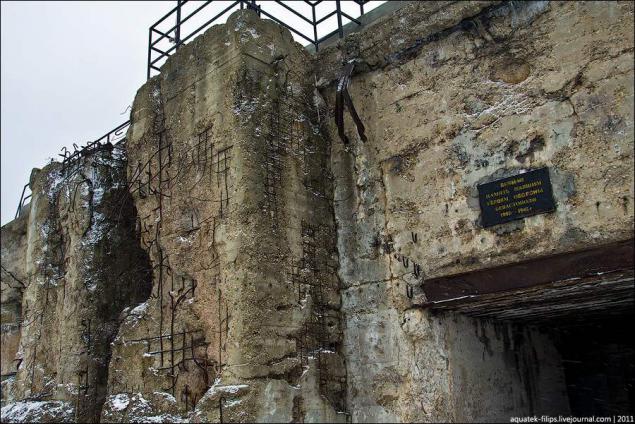
4. Go through the main entrance, you can get into one of the destroyed artillery units. Here one can see traces of the explosions everywhere - broken concrete and twisted metal design
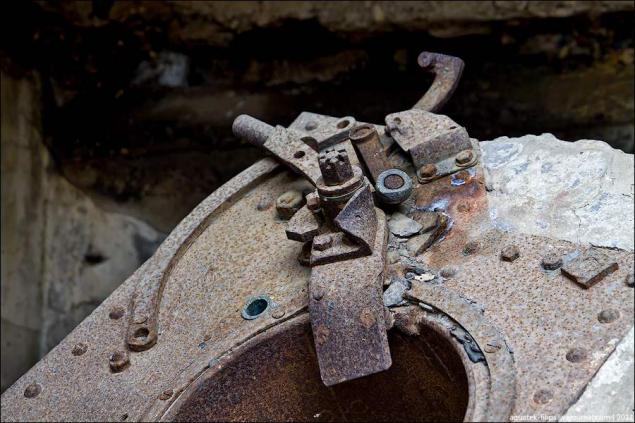
5. Within the first branch to the right leads to the dungeons, where you should be very careful - after the explosion collapsed the battery overlap and there are large gaps in the lower floor. For safety reasons, not all of the museum is freely accessible. Sometimes he closed found here remains of shells

6. If you walk along the corridor further through the holes you can see that two of the lower areas flooded, dry one, between them, they are not reported. According to the workers of the museum, until 1999, one of the failures was on top of the rubble of concrete filled when made clearing, then flooding the room discovered the remains of fighters, weapons and documents ...
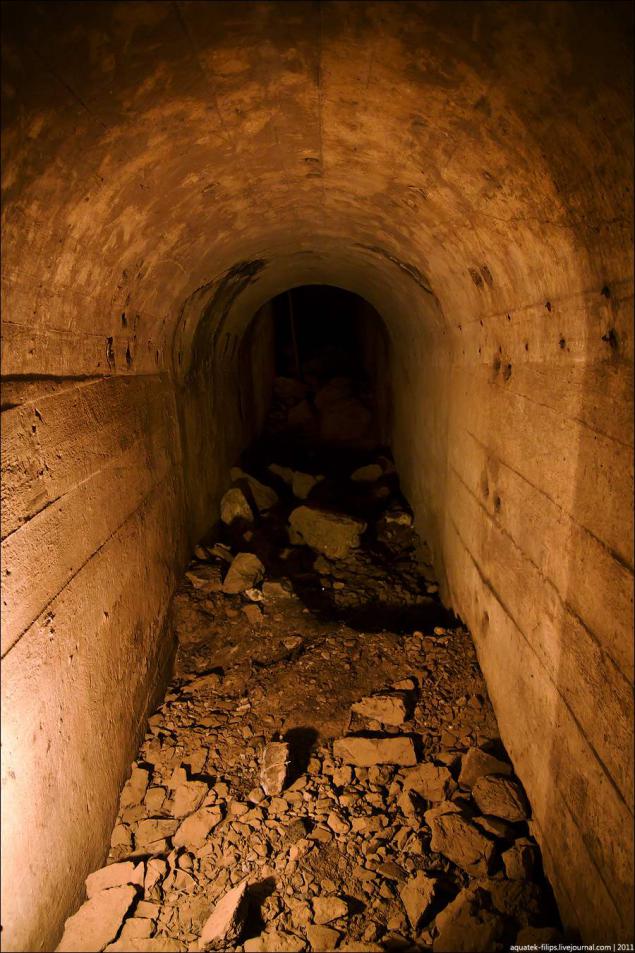
7. The battery is a communication system connecting the two gun range, storage for shells, para adjust fire, underground power, ventilation and pumping stations, a network of special facilities and inspection gallery leading to the sea. There are also non-communication underground structures. In the central part of the premises is the main exposition.
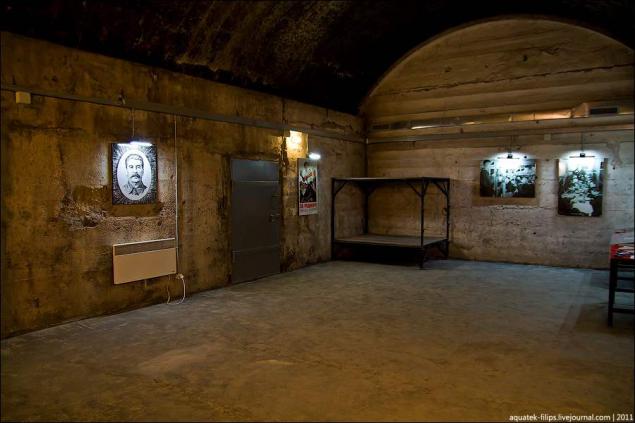
8. There are a lot of photos taken at the premises during the defense of Sevastopol - such is the picture on the background of a portrait of Stalin Lenin made in the room of the 35th Battery in 1941, the year
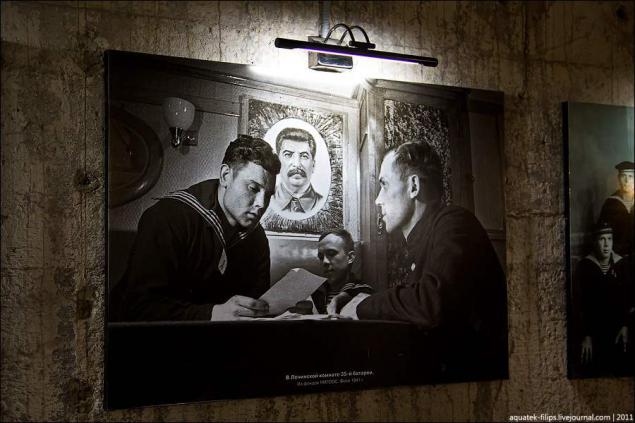
9. And this is the portrait, which is made on the background of the previous photo
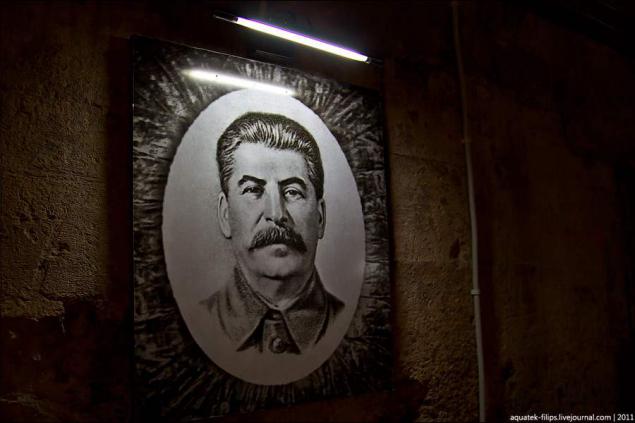
10. The next room makes the stay here a long time. Here, during the war we fought to the death of seriously wounded soldiers and doctors of the hospital room ... the defenders of the battery. Under Scrutiny - tiles on the floor wiped down.
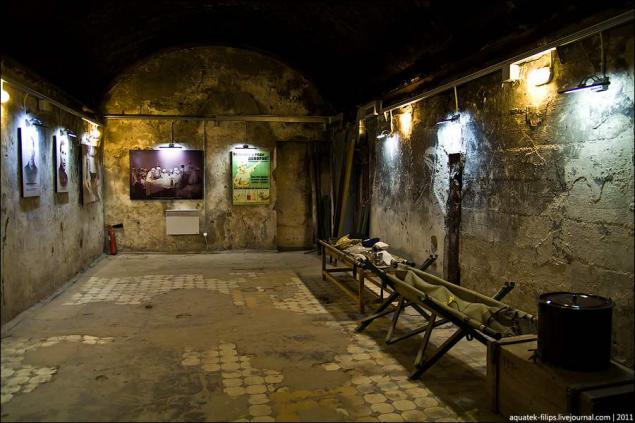
11. Live two narcissus drove my throat lump ... It is difficult to cope with the emotions

12. That, whereby doctors fought for the lives of the wounded
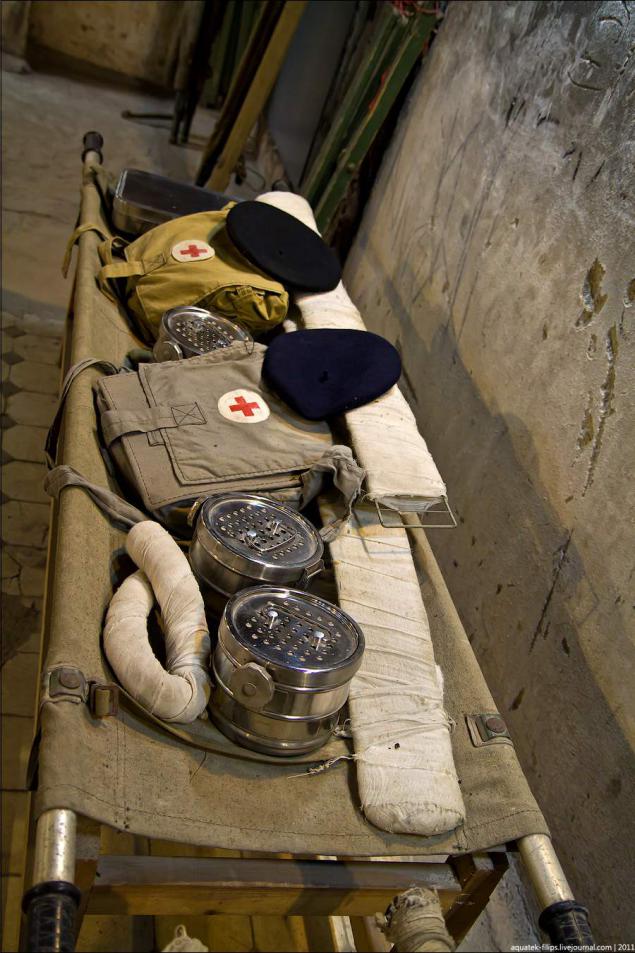
13. Everywhere on the walls should be cut cables and communications
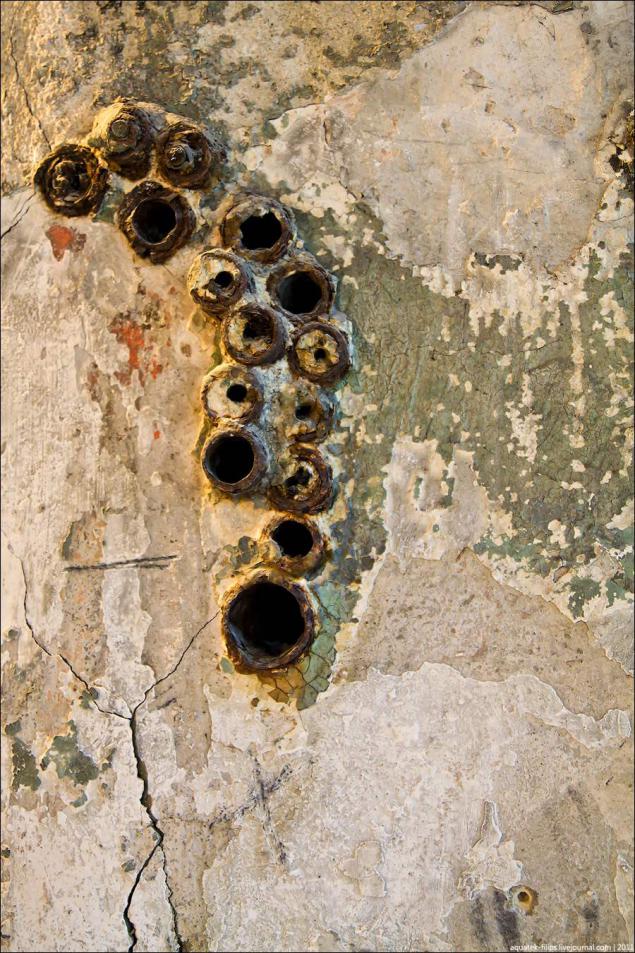
14. Entrance to the cabin. It was here June 30, 1942 took place the last joint meeting of the military councils of the COP and the Maritime Army, the results of which it was decided to end the defense of Sevastopol and evacuation officers. He ordered the commander of the end of the October batteries provide cover evacuation and expenditure of ammunition to undermine the tools and mechanisms.
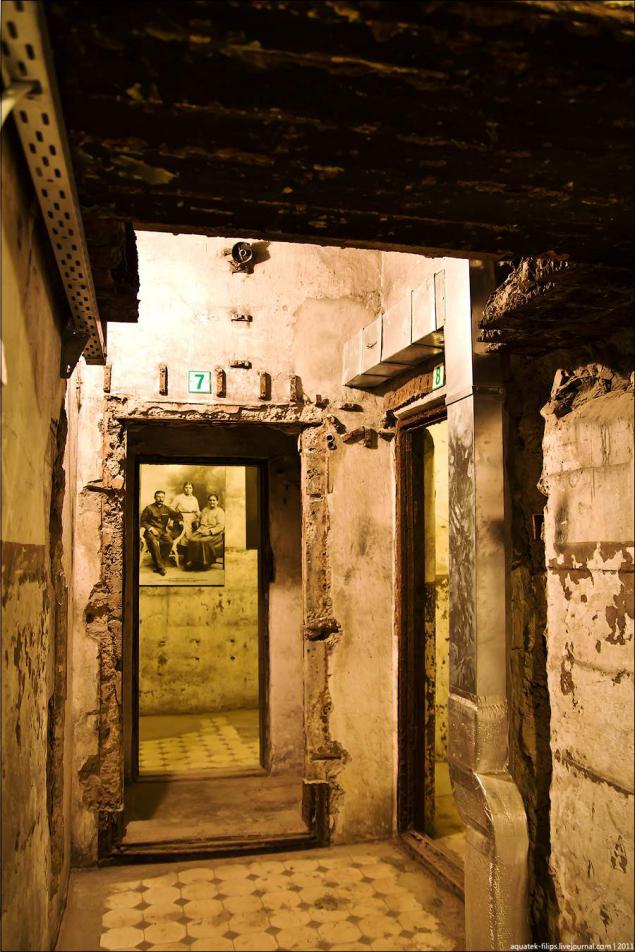
15. From the main entrance stretches a network of tunnels and communications, have access to the surface and to the turning of gun range. By cannon circles, where the gun turrets on all sides out of special openings of four in the group that was fed through the shells into adjacent casemates were racks for shells.

16. Part of the premises is severely damaged by explosions, there are blockages, which can not pass through. Entrance hall of the former power station - after the explosion, he is a jumble of concrete blocks and jagged metal.
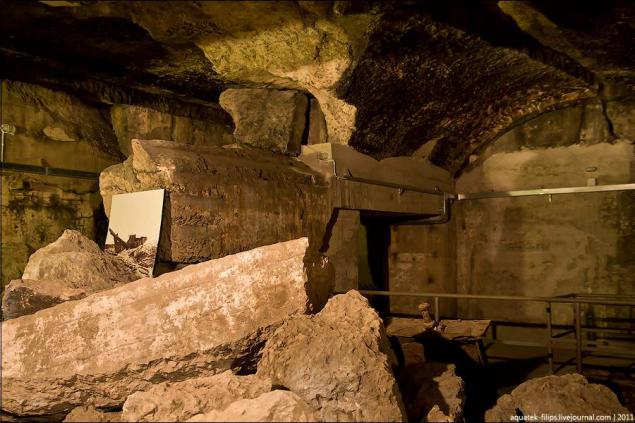
17. Twisted 30-meter ladder descending to the right command post
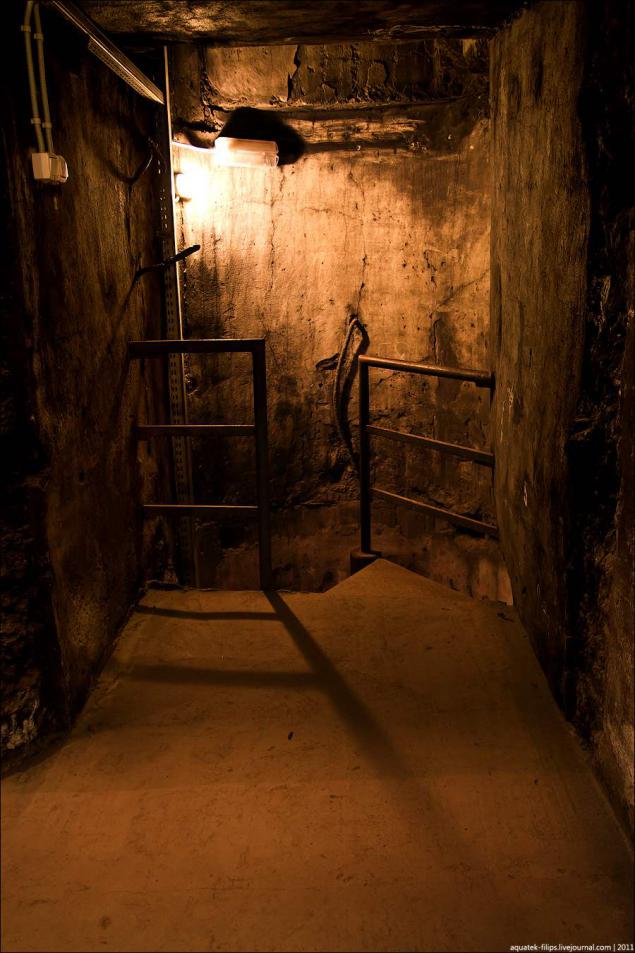
18. Long Paterna to the command - about 450 meters sinister corridor
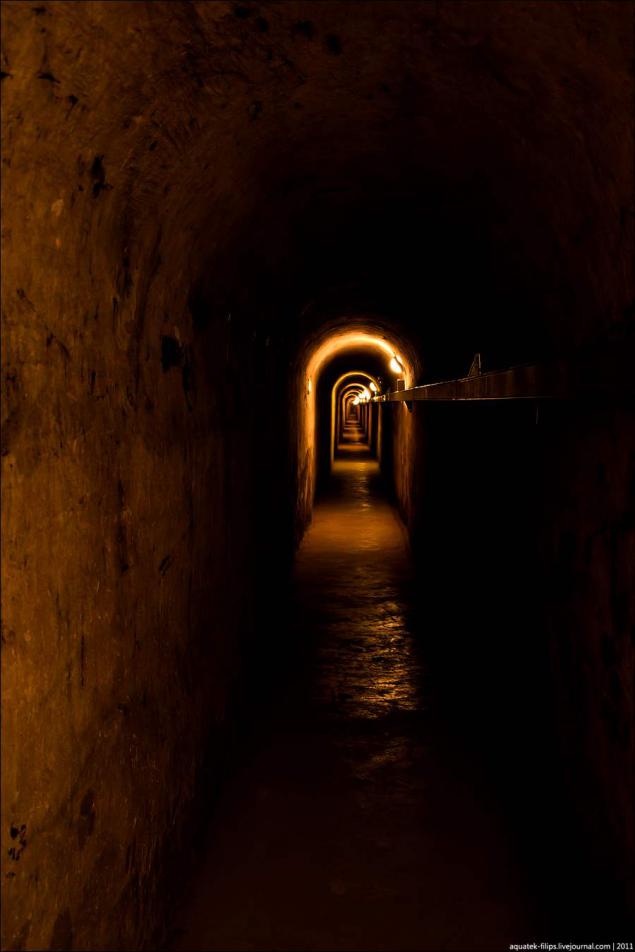
19. Time and metal. The remains of the loops in the mess
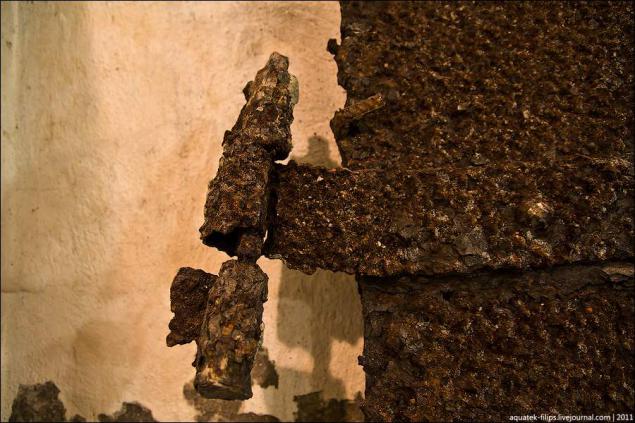
20. Left rangefinder. Externally, it was restored
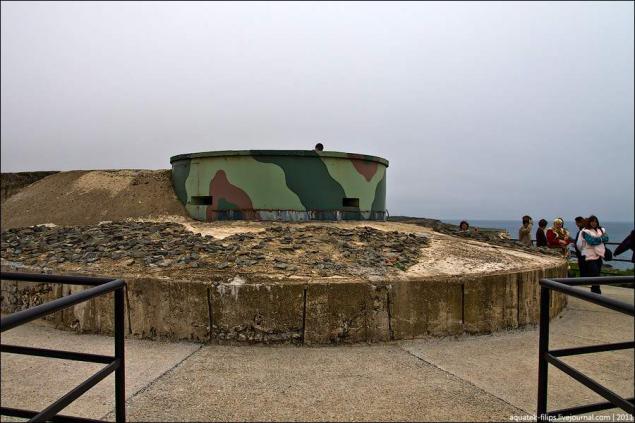
21. In the vestibule room, previously served as the central power station is now a wall of grief, which lit candles and lay fresh flowers
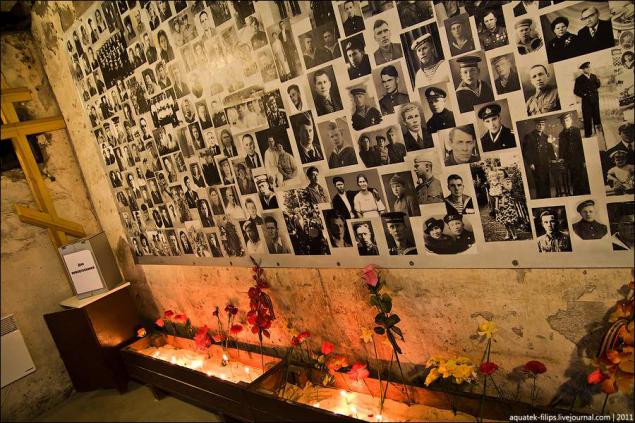
22. On the wall of photos of the defenders of Sevastopol, which will forever remain in the distant 1941-192 years ... Looking at their faces - sometimes funny, sometimes focused - you understand - these people were living, happy, create, and in a moment of their lives was lost as the millions of lives interrupted in that war ...
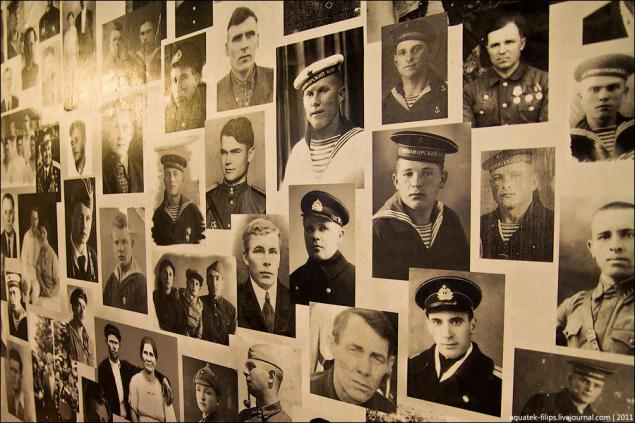
23.

24.
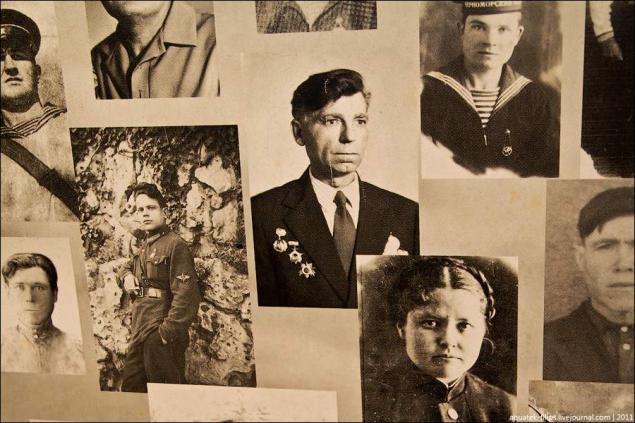
25.
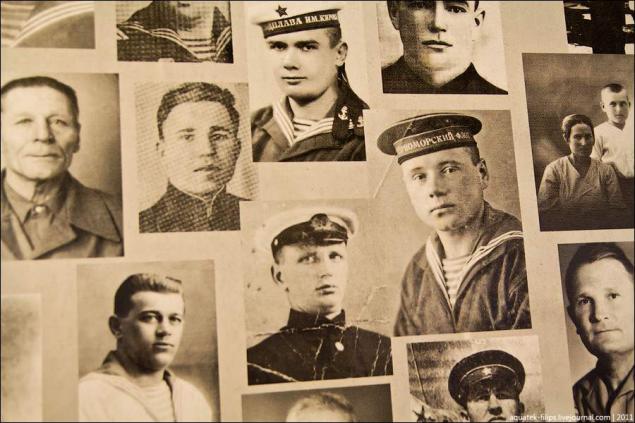
26
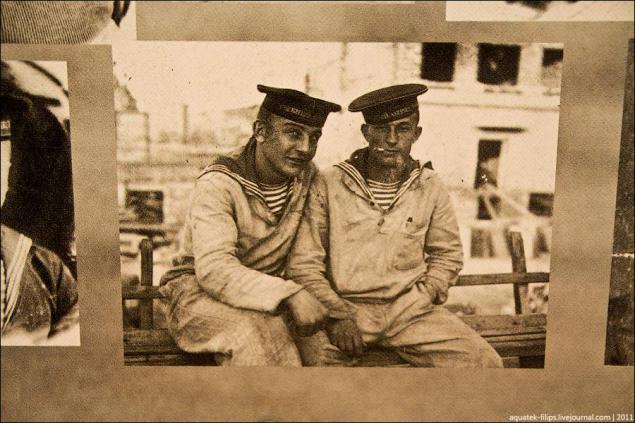
27. And at the entrance is a visitors' book. Blog lot. Thank you for the eternal memory, eternal glory ...
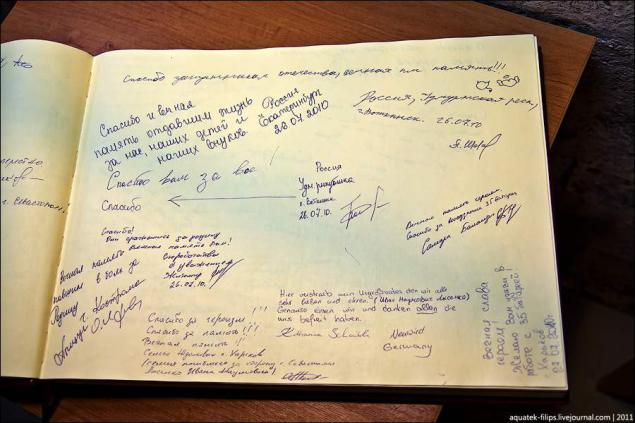
28
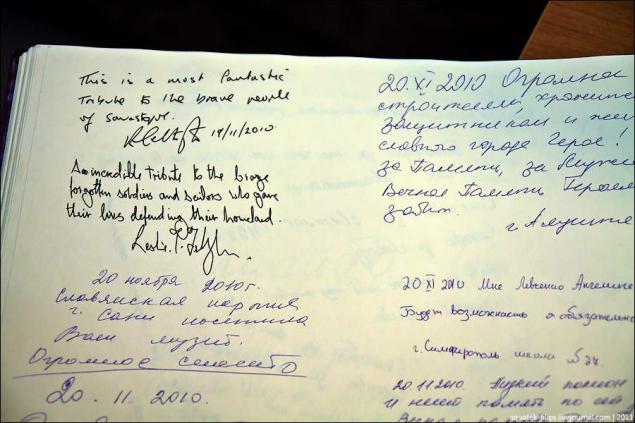
29. In addition to the main tower structures, there are a number of auxiliary facilities plan unrelated to the main communication - observation posts, bunkers.
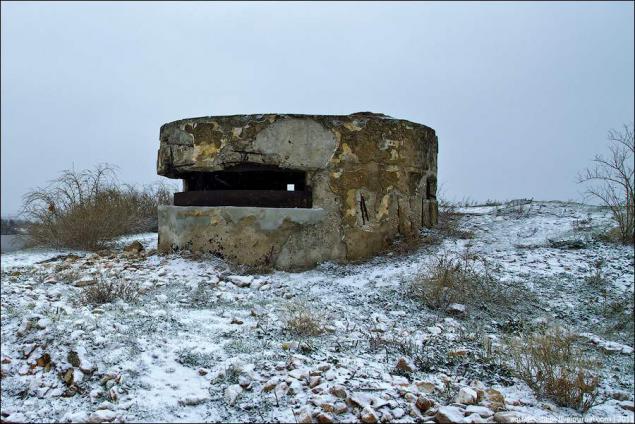
30. Inside, they look the same in those terrible days. Only add to the label of the Vandals burnt walls war
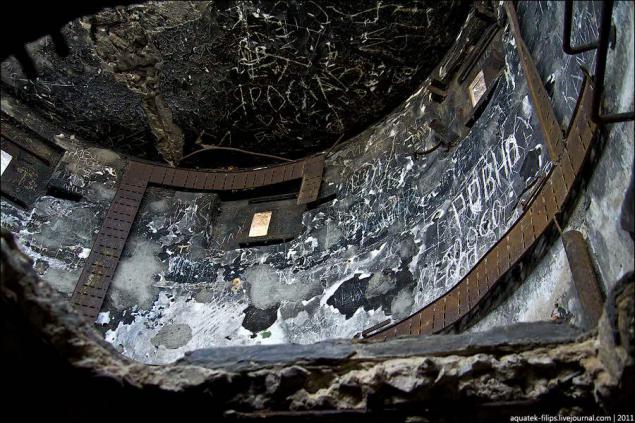
31. Rusty stairs from the bunker into the tower. Staples barely keep
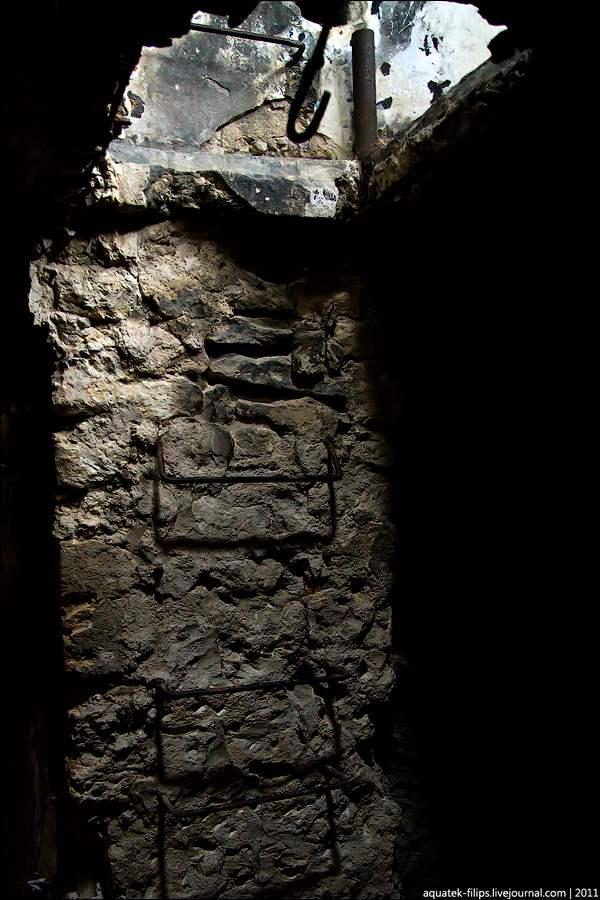
32. Putting casemates
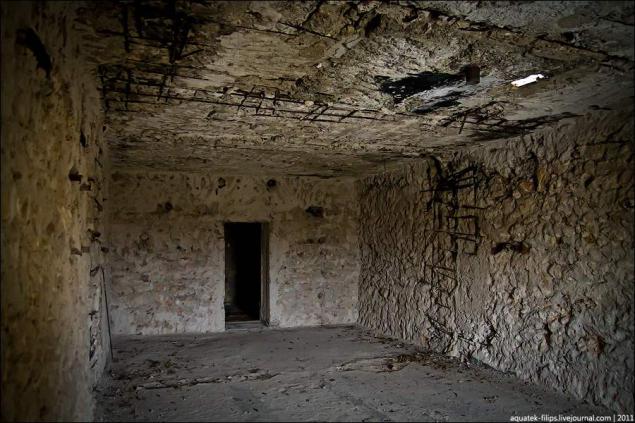
33. The same observation post, but spring
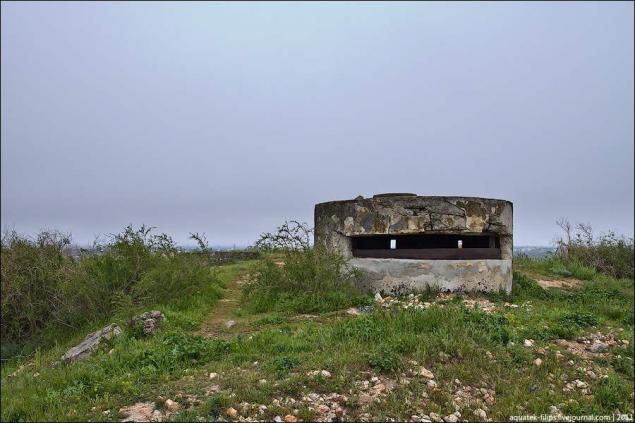
34. One of the few windows ...
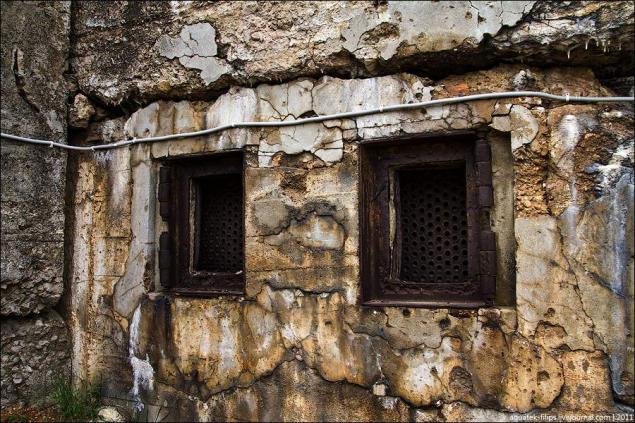
35. Panorama inside the unit of the former gun tower №2

36. The same gun unit in the winter top
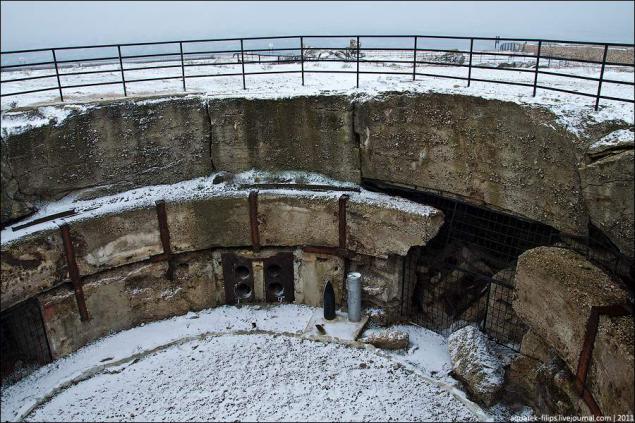
After a photo-tour a little more about the history of the battery.
One of the results of the analysis of defense of the fortress of Port Arthur during the Russian-Japanese war of 1905 was the decision to build on the commanding heights on the wings of Sevastopol defensive area the two most powerful on the Black Sea shore batteries: №30 - near the village of Lyubimovka, at the mouth of the river Belbek, number 35 - at Cape Chersonese. Each battery had 4 caliber 305 mm guns mounted in two rotating cupola (the battery №30 - one artillery unit into two cupola, and the battery №35 - two artillery unit on the cupola one each). The amount of concrete work on each of the batteries of approximately equal volume of work during the construction of the Dnieper.
On your device battery consisted of two artillery units (reinforced concrete blocks, which were installed gun turrets). Within a block of the 1st tower on two floors housed the cellar of ammunition, residential and office space, and inside the 2nd tower power station in addition and the central post with the fire control devices. 450 m north and 200 m south of the blocks placed command posts with armored conning tower and open courtyards for rangefinders. Gun units and command centers were connected by underground corridors (Poterna). There were two emergency exits to the coast. After completion of the battery received a number of 8 and became a member of the 6th Artillery Regiment serf. Its first commander was G.V.Shteynberg. In 1930, the battery got a new number - 35.
The domination of the surrounding area provided a cupola, rotates through 360 degrees, the circular firing. Maximum range of up to 42 km. Both batteries - 30 th and 35 th was originally built as a shore, ie have been designed to combat enemy ships. But when in October 1941, German troops invaded the Crimea, the coastal batteries designed to protect Sevastopol from the sea, have become a major caliber defense of the city from the land.
The first live firing batteries in the defense of Sevastopol in 1941-1942. It was held November 7, 1941 in parts of the German 132nd Infantry Division in the district of Mackenzie farm. Heavy wear guns and the intensity of the fighting (in two months produced more than 300 rounds per gun at a rate of 200) already made December 1, 1941 to begin work on replacing the gun barrels of the 1st tower, which were conducted by experts Artillery Repair Plant №1127, therefore, During December were only firing 2nd tower.
17 December 1941 during an intense fire at the enemy launched an assault of Sebastopol in the 2nd tower as a result of a premature shot (ignition of gunpowder charge when not fully closed the gate) there was a strong explosion, who brought her completely out of order. Failure of artillery batteries and the critical situation on the land front was forced to pass most of the personnel in the Marines (most of them died in battles in the mountains Mekenzievyh and survivors in January 1942 were returned to the battery).
The reconstruction of the 2nd tower (in which workers participated Sevastopol Marine Plant. Ordzhonikidze) and replacement gun barrels lasted about 2, 5 months. Between June 1942 Battery daily battles waged fire on the attacking enemy troops, and after the death surrounded by the 30th Battery was the last reserve of heavy artillery of the Sevastopol Defense Region.
The battery was subjected to continuous bombing by the Nazis from the air and shelling from heavy and heavy guns. According to the memoirs of the commander of the German army in the Crimea, Manstein, "the whole of the Second World War, the Germans never reached such massive use of artillery in the attack on Sevastopol." According to his testimony, under the city, not for nothing called the "most impregnable fortress in the world", "in the midst of high power batteries were cannon battery systems with up to 190 mm caliber, and several howitzers and mortars batteries caliber 305, 350 and 420 mm. In addition, there were two special guns caliber 600 mm [mortar type "Carl"] and the famous gun "Dora" caliber 800 mm ».
In early July 1942 the casemates of the 35th Battery and caves of Cape Khersones witnessed one of the darkest chapters of the defense of Sevastopol. Dropped to Cape Soviet soldiers and sailors left without supplies and without hope of evacuation, desperately fought literally to the last bullet. Tens of thousands of terribly bruised, wounded and almost unarmed men, even deprived of the possibility to resist, fell into German captivity.
June 30 radio center Battery Commander - Vice-Admiral FS Oktyabrsky to the People's Commissar of the Navy was sent cryptograms with a report on the impossibility of further retention of Sevastopol and requesting evacuation commanders.
In the evening of the same day in kayutkompanii battery held a joint meeting last military councils of the Sevastopol Defense Region and the Maritime Army. He ordered the commander of the end of the October batteries provide cover evacuation and expenditure of ammunition to undermine the tools and mechanisms. During the day, July 1 2nd tower held several firings of motorized units of the German 72th Infantry Division in the district of Cape Fiolent (fire was practical nuclei because live ammunition has been spent). Last firing battery was carried shrapnel in p-well Kamyshovaya beams. On the night of July 2, the personnel of the batteries have been undermined both towers and power station, but an inspection gallery and most of the buildings have survived and artillery units in them until July 12, 1942 continued resistance to the last defenders of Sevastopol ...
After the war, the 35th Battery was not restored, but some of its facilities (the right wing of the 2nd block of the tower and right command post) used established in 1945 at Cape Chersonese 130-mm coastal battery №723 (it was disarmed in 1960). In 1988, the right command post of the 35th of the battery and its 450-meter inspection gallery was equipped Seismological Laboratory Simferopol State University them. Frunze.
Source:
This report I prepared for a long time, trying to make it as interesting as possible for both the reader and encourage thinking about the historical role of the place, which will be discussed. To this end, I traveled twice to take photographs with interest picking up historical facts.
35 Battery.
The site, which is one of the most sacred for many residents of Sevastopol.
The site, which in June and July 1942 was the last snout heroic defense of Sevastopol for the remaining 80 thousand of its defenders.
The place where it was made the fateful decision to terminate the defense and evacuation command structure.
The place has become a sort of quintessence of both the national and exploit the people's tragedy ...
36 photos
1. boulder over the Nazis blasted by artillery unit resembles grieving for the dead soldier

35th Coastal Battery tower - one of the most powerful fortifications of the coastal defense of the Black Sea Fleet's main base. Started construction in 1913 on Cape Khersones on the project of the military engineer General N.A.Buynitskogo. Initially had a number 25. In 1915, construction was halted, and the battery is being completed in 1924-1927. She was armed with two 305-mm twin tower installations "MB-2-12", designed and manufactured the Leningrad Metal Plant (gun machines and machine parts have been used to cook - shot of the towers of the battleship "Poltava" Baltic Fleet). The weight of the projectile - 471 kg, and range - up to 42 km. On your device battery consisted of two artillery units (reinforced concrete blocks, which were installed gun turrets). One of the destroyed artillery units I have shown in the first photo. In the second gun unit can be reached through the main entrance to the museum 35 battery. But more detail about the history of the battery, I will write to the end of the report, but for now - photo-excursion.
2. The main entrance to the main premises battery

In the postwar period, the 35th coastal battery was not restored, but some of its buildings used for existing 130-mm coastal battery, so look for us to strengthen remained virtually intact.
3. On the day when I went to shoot the battery went to Sevastopol rare snow. Scratchy, as if emphasizing the tragedy of this place. Reinforced concrete structures now have the form, remaining after the events of the distant 1942

4. Go through the main entrance, you can get into one of the destroyed artillery units. Here one can see traces of the explosions everywhere - broken concrete and twisted metal design

5. Within the first branch to the right leads to the dungeons, where you should be very careful - after the explosion collapsed the battery overlap and there are large gaps in the lower floor. For safety reasons, not all of the museum is freely accessible. Sometimes he closed found here remains of shells

6. If you walk along the corridor further through the holes you can see that two of the lower areas flooded, dry one, between them, they are not reported. According to the workers of the museum, until 1999, one of the failures was on top of the rubble of concrete filled when made clearing, then flooding the room discovered the remains of fighters, weapons and documents ...

7. The battery is a communication system connecting the two gun range, storage for shells, para adjust fire, underground power, ventilation and pumping stations, a network of special facilities and inspection gallery leading to the sea. There are also non-communication underground structures. In the central part of the premises is the main exposition.

8. There are a lot of photos taken at the premises during the defense of Sevastopol - such is the picture on the background of a portrait of Stalin Lenin made in the room of the 35th Battery in 1941, the year

9. And this is the portrait, which is made on the background of the previous photo

10. The next room makes the stay here a long time. Here, during the war we fought to the death of seriously wounded soldiers and doctors of the hospital room ... the defenders of the battery. Under Scrutiny - tiles on the floor wiped down.

11. Live two narcissus drove my throat lump ... It is difficult to cope with the emotions

12. That, whereby doctors fought for the lives of the wounded

13. Everywhere on the walls should be cut cables and communications

14. Entrance to the cabin. It was here June 30, 1942 took place the last joint meeting of the military councils of the COP and the Maritime Army, the results of which it was decided to end the defense of Sevastopol and evacuation officers. He ordered the commander of the end of the October batteries provide cover evacuation and expenditure of ammunition to undermine the tools and mechanisms.

15. From the main entrance stretches a network of tunnels and communications, have access to the surface and to the turning of gun range. By cannon circles, where the gun turrets on all sides out of special openings of four in the group that was fed through the shells into adjacent casemates were racks for shells.

16. Part of the premises is severely damaged by explosions, there are blockages, which can not pass through. Entrance hall of the former power station - after the explosion, he is a jumble of concrete blocks and jagged metal.

17. Twisted 30-meter ladder descending to the right command post

18. Long Paterna to the command - about 450 meters sinister corridor

19. Time and metal. The remains of the loops in the mess

20. Left rangefinder. Externally, it was restored

21. In the vestibule room, previously served as the central power station is now a wall of grief, which lit candles and lay fresh flowers

22. On the wall of photos of the defenders of Sevastopol, which will forever remain in the distant 1941-192 years ... Looking at their faces - sometimes funny, sometimes focused - you understand - these people were living, happy, create, and in a moment of their lives was lost as the millions of lives interrupted in that war ...

23.

24.

25.

26

27. And at the entrance is a visitors' book. Blog lot. Thank you for the eternal memory, eternal glory ...

28

29. In addition to the main tower structures, there are a number of auxiliary facilities plan unrelated to the main communication - observation posts, bunkers.

30. Inside, they look the same in those terrible days. Only add to the label of the Vandals burnt walls war

31. Rusty stairs from the bunker into the tower. Staples barely keep

32. Putting casemates

33. The same observation post, but spring

34. One of the few windows ...

35. Panorama inside the unit of the former gun tower №2

36. The same gun unit in the winter top

After a photo-tour a little more about the history of the battery.
One of the results of the analysis of defense of the fortress of Port Arthur during the Russian-Japanese war of 1905 was the decision to build on the commanding heights on the wings of Sevastopol defensive area the two most powerful on the Black Sea shore batteries: №30 - near the village of Lyubimovka, at the mouth of the river Belbek, number 35 - at Cape Chersonese. Each battery had 4 caliber 305 mm guns mounted in two rotating cupola (the battery №30 - one artillery unit into two cupola, and the battery №35 - two artillery unit on the cupola one each). The amount of concrete work on each of the batteries of approximately equal volume of work during the construction of the Dnieper.
On your device battery consisted of two artillery units (reinforced concrete blocks, which were installed gun turrets). Within a block of the 1st tower on two floors housed the cellar of ammunition, residential and office space, and inside the 2nd tower power station in addition and the central post with the fire control devices. 450 m north and 200 m south of the blocks placed command posts with armored conning tower and open courtyards for rangefinders. Gun units and command centers were connected by underground corridors (Poterna). There were two emergency exits to the coast. After completion of the battery received a number of 8 and became a member of the 6th Artillery Regiment serf. Its first commander was G.V.Shteynberg. In 1930, the battery got a new number - 35.
The domination of the surrounding area provided a cupola, rotates through 360 degrees, the circular firing. Maximum range of up to 42 km. Both batteries - 30 th and 35 th was originally built as a shore, ie have been designed to combat enemy ships. But when in October 1941, German troops invaded the Crimea, the coastal batteries designed to protect Sevastopol from the sea, have become a major caliber defense of the city from the land.
The first live firing batteries in the defense of Sevastopol in 1941-1942. It was held November 7, 1941 in parts of the German 132nd Infantry Division in the district of Mackenzie farm. Heavy wear guns and the intensity of the fighting (in two months produced more than 300 rounds per gun at a rate of 200) already made December 1, 1941 to begin work on replacing the gun barrels of the 1st tower, which were conducted by experts Artillery Repair Plant №1127, therefore, During December were only firing 2nd tower.
17 December 1941 during an intense fire at the enemy launched an assault of Sebastopol in the 2nd tower as a result of a premature shot (ignition of gunpowder charge when not fully closed the gate) there was a strong explosion, who brought her completely out of order. Failure of artillery batteries and the critical situation on the land front was forced to pass most of the personnel in the Marines (most of them died in battles in the mountains Mekenzievyh and survivors in January 1942 were returned to the battery).
The reconstruction of the 2nd tower (in which workers participated Sevastopol Marine Plant. Ordzhonikidze) and replacement gun barrels lasted about 2, 5 months. Between June 1942 Battery daily battles waged fire on the attacking enemy troops, and after the death surrounded by the 30th Battery was the last reserve of heavy artillery of the Sevastopol Defense Region.
The battery was subjected to continuous bombing by the Nazis from the air and shelling from heavy and heavy guns. According to the memoirs of the commander of the German army in the Crimea, Manstein, "the whole of the Second World War, the Germans never reached such massive use of artillery in the attack on Sevastopol." According to his testimony, under the city, not for nothing called the "most impregnable fortress in the world", "in the midst of high power batteries were cannon battery systems with up to 190 mm caliber, and several howitzers and mortars batteries caliber 305, 350 and 420 mm. In addition, there were two special guns caliber 600 mm [mortar type "Carl"] and the famous gun "Dora" caliber 800 mm ».
In early July 1942 the casemates of the 35th Battery and caves of Cape Khersones witnessed one of the darkest chapters of the defense of Sevastopol. Dropped to Cape Soviet soldiers and sailors left without supplies and without hope of evacuation, desperately fought literally to the last bullet. Tens of thousands of terribly bruised, wounded and almost unarmed men, even deprived of the possibility to resist, fell into German captivity.
June 30 radio center Battery Commander - Vice-Admiral FS Oktyabrsky to the People's Commissar of the Navy was sent cryptograms with a report on the impossibility of further retention of Sevastopol and requesting evacuation commanders.
In the evening of the same day in kayutkompanii battery held a joint meeting last military councils of the Sevastopol Defense Region and the Maritime Army. He ordered the commander of the end of the October batteries provide cover evacuation and expenditure of ammunition to undermine the tools and mechanisms. During the day, July 1 2nd tower held several firings of motorized units of the German 72th Infantry Division in the district of Cape Fiolent (fire was practical nuclei because live ammunition has been spent). Last firing battery was carried shrapnel in p-well Kamyshovaya beams. On the night of July 2, the personnel of the batteries have been undermined both towers and power station, but an inspection gallery and most of the buildings have survived and artillery units in them until July 12, 1942 continued resistance to the last defenders of Sevastopol ...
After the war, the 35th Battery was not restored, but some of its facilities (the right wing of the 2nd block of the tower and right command post) used established in 1945 at Cape Chersonese 130-mm coastal battery №723 (it was disarmed in 1960). In 1988, the right command post of the 35th of the battery and its 450-meter inspection gallery was equipped Seismological Laboratory Simferopol State University them. Frunze.
Source:

